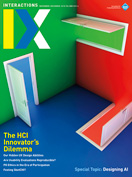Authors:
Jason Wong
As artificial intelligence (AI) and machine learning's (ML) prominence in daily human-to-computer interaction grows, the field of interaction design must shift to understand the possibilities, limitations, and biases of AI. Currently, academia and technology corporations are leading the way in research and implementation, working in distinct fields such as natural language processing and object recognition. There has been enormous progress, as AI, supported by deep learning [1], is very good at completing a discrete task such as scheduling an appointment [2]. But it's not capable of completing a more general intellectual task, such as knowing how and when to…
You must be a member of SIGCHI, a subscriber to ACM's Digital Library, or an interactions subscriber to read the full text of this article.
GET ACCESS
Join ACM SIGCHIIn addition to all of the professional benefits of being a SIGCHI member, members get full access to interactions online content and receive the print version of the magazine bimonthly.
Subscribe to the ACM Digital Library
Get access to all interactions content online and the entire archive of ACM publications dating back to 1954. (Please check with your institution to see if it already has a subscription.)
Subscribe to interactions
Get full access to interactions online content and receive the print version of the magazine bimonthly.






